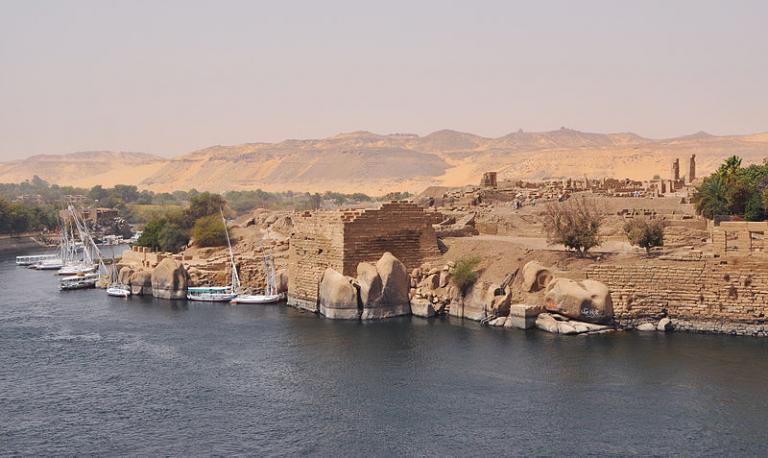
I published the column below on 26 October 2017 in the Deseret News:
Many years ago, I was accompanying a group of Latter-day Saint tourists in Egypt. At one point, our local guide took us to a restaurant on an island in the Nile River near Aswan. Suddenly realizing where we were, I pointed excitedly to some ruins at the southern end of an adjacent island, exclaiming to my puzzled companions that it was one of the most important of all Book of Mormon archaeological sites. Then I explained why:
According to the Book of Mormon (see, for example, 1 Nephi 2:5), around the beginning of the sixth century before Christ there lived a woman in or near Jerusalem by the name of “Sariah.” However, no woman appears in the Bible bearing that name. “Sarai,” Abraham’s wife, comes the closest. Her name probably means “my princess” or “my lady.” Later, she’s called “Sarah” (“princess.”) But “Sariah” is quite distinct.
So did Joseph Smith simply invent the name? Definitely not.
In unvowelled Hebrew, “Sariah” would almost certainly be spelled “sryh,” and it would be pronounced something like “Saryah.” Although “sryh” is not found in the Bible as a female name, it is well documented as an ancient Israelite masculine name. In fact, it’s attached to eleven different men in the Hebrew Bible, appearing a total of nineteen times. In the King James Bible, it’s spelled “Seraiah,” which is presumably a shortened form of “sryhw” or “Saryahu,” where the element “Yahu” derives from the divine name “Yahuweh” or “Jehovah.” (That longer form actually does appear in the Hebrew of Jeremiah 36:26, as well as in several Iron Age seals and clay bullae.)
So perhaps Joseph Smith took the name “Seraiah” from the Old Testament but misspelled it and misapplied it to a woman? Again, apparently not.
As Jeffrey Chadwick pointed out in a 1993 article, the Hebrew name “Sariah,” spelled “sryh,” has been reconstructed by non-Mormon scholars and identified as the Hebrew name of a Jewish woman who lived at Elephantine in Upper Egypt during the fifth century B.C. To be precise, she lived on that small island that so excited me. It was known to the ancient Egyptians as “3bw” (“Elephant” or “Ivory”) and to the Greeks as “Elephantine,” which reflects the importance of Aswan, in the far south of Egypt, to the ivory trade with inner Africa.
The reference to Sariah of Elephantine is found in line 4 of Aramaic Papyrus #22 (also called Cowley #22 or C-22), where she is described as “Seraiah, daughter of Hoshea son of Harman.” Her name may mean either “Yah (or Yahuweh) has struggled” or “Yah (or Yahuweh) is prince.” And “Sariah” may be the better spelling.
In other words, “Sariah” seems to be an authentically ancient Hebrew feminine name. Yet the Elephantine Papyri were discovered around the beginning of the twentieth century, far too late for Joseph Smith to have studied them.
But there’s more.
Why is this Sariah mentioned in Papyrus C-22? Because she had donated two shekels of silver to “Yahu Elaha,” “the Lord God.” Arthur Cowley, after whom the papyrus was named, believed that her donation, which he dates to the year 419 BC, went to the expenses of the Jewish temple that we know to have been constructed on Elephantine Island.
An Israelite temple outside of Jerusalem? Yes, indeed. Directly parallel to the temple “like unto the temple of Solomon” that Nephi constructed in the Americas (2 Nephi 5:16), it was built by a colony of Jewish soldiers that had probably been established there sometime in the seventh century—i.e., during Lehi’s early years—when Judah was subservient to Egypt.
“For Latter-day Saint students today,” summarizes Chadwick, “the historical parallels between Sariah of Elephantine and Sariah the wife of Lehi are interesting, even if coincidental. Aside from sharing the same Hebrew name and the same Judahite-Israelite background, both women lived a great distance from Jerusalem. One’s location would indicate that she probably used Egyptian as a language in addition to Aramaic, whereas the other’s husband and at least one son were schooled in “the language of the Egyptians” as well as their native Hebrew tongue (1 Nephi 1:2). Both women reverenced “the Lord God” (Aramaic “Yahu Elaha”; compare 2 Nephi 5:30). Both women lived among Judahite-Israelite colonies that built their own temples outside the sphere of the temple at Jerusalem.”
See Jeffrey R. Chadwick, “Notes and Communications: Sariah in the Elephantine Papyri,” “Journal of Book of Mormon Studies” 2/2 (1993) (https://publications.mi.byu.edu/fullscreen/?pub=1379&index=13).
And now, of course, that column should be supplemented with
“Revisiting “Sariah” at Elephantine”
See, too, this three-minute video:
“New Archaeological Evidence for Sariah as a Hebrew Woman’s Name”
Posted from Cairo, Egypt












